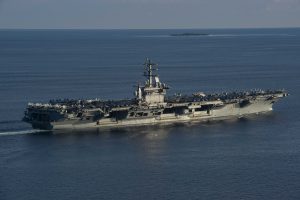In August, China launched several anti-ship ballistic missiles into the South China Sea. Now sources close to the Chinese military claim that the missiles did not simply fall into the sea but successfully hit a moving target ship.
The South China Morning Post (SCMP) first reported that DF-21D and DF-26B anti-ship ballistic missiles were launched from separate sites on August 26 and travelled thousands of kilometers before splashing down in the South China Sea somewhere between the Paracel Islands and Hainan Island. The Pentagon later confirmed that China tested ballistic missiles that landed near the Paracel Islands during exercises that week but offered no details about the launch.
The DF-21D is believed to have a range of about 1,500 kilometers and U.S. Department of Defense reported that the anti-ship variant reached an early capability in 2010. The missile was dubbed the “carrier killer” for possibly being able to hit U.S. aircraft carriers far out to sea.
The DF-26B has a much longer range of around 4,000 kilometers, leading some to call it the “Guam Express” because it could theoretically target U.S. military bases on the island of Guam.
Now the SCMP says that those missiles successfully struck a maneuvering vessel at sea according to remarks made by a former senior Chinese officer, Wang Xiangsui, who now works as a professor in Beijing.
Over the summer the launches were interpreted as a message to the United States after a U.S. spy plane overflew Chinese naval exercises in the Bohai Sea the day before. Chinese officials complained that the flight disrupted its naval drills.
That summer saw intense activity in the South China Sea from both the U.S. Navy and the People’s Liberation Army (PLA) Navy. Two U.S. carrier groups operated together in the South China Sea in July at least twice, in a rare concentration of U.S. naval power, and individual carrier groups operated in and around the sea throughout the summer. China conducted extensive naval drills of its own in the South China Sea in July and August.
Wang implied that the test was linked to the spy plane flight and in particular the arrival of a U.S. aircraft carrier group in the South China Sea nearly two weeks before that. SCMP reports that Wang said that “…several days later [after the aircraft carrier maneuvers], we launched the DF-21 and DF-26, and the missiles hit a vessel sailing south of the Paracel Islands. Shortly after that, an American military attaché in Geneva complained [to us] and said it would lead to severe consequences if the missiles hit an American aircraft carrier. They see this as a show of force. But we are doing this because of their provocation.”
Official Chinese outlets have not confirmed whether the missiles did in fact hit a moving target. Given how high-profile the weapons are and their importance to the PLA’s ability to deter the U.S. Navy from operating close to China’s shores, if the tests were successful it would be unusual to keep their results secret.
Despite the alignment of events, it is questionable whether China could safely organize and conduct a complex missile test on a couple weeks’ notice to respond to the U.S. aircraft carrier’s arrival in mid-August. It may be more likely that the test had been planned for some time and the U.S. carrier’s presence was coincidental, if predictable. China published the target area that the missiles landed in on August 21 to warn ships and aircraft to avoid the area, less than a week after the carrier arrived, and five days before the missiles were tested.
The Pentagon estimates that China has more than 150 medium-range ballistic missiles like the DF-21 and more than 200 intermediate-range ballistic missiles like the DF-26. It is not reported how many of these missiles are variants that can hit moving naval targets. China is known to be improving satellite and long-range radar systems to boost its ability to target ships at sea, but it is unclear how effectively or at what ranges the DF-21 and DF-26 can reliably hit a moving vessel.

































